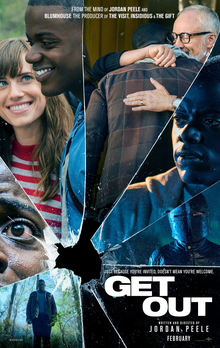“Logan,” “Get Out,” and the Purpose of Violence

Theatrical Release Poster
March 20, 2017
Violence in films has long been a hotly debated topic. This debate mostly happens in relation to the rating of a film versus the amount of violence in it; however, in the conversation on the amount of violence in movies, the use of violence in movies gets lost. While many movies have violence, very few use it to a pointed effect. “Logan” and “Get Out” are both excellent examples of movies that use violence to paint pictures of the characters and their situations (spoilers ahead).
“Logan” centers around the relationship between Logan (aka Wolverine) and Laura, a clone of Wolverine who shares his special abilities. The film features what would be considered a gratuitous amount of violence by even the most liberal of standards: throats are sliced, heads are chopped off, limbs are removed with reckless abandon. But in the world of “Logan,” violence never happens without reason. In the very first scene, Logan brutally kills men attempting to steal parts off of his car, but his initial reluctance to do so tells the audience everything we need to know about his relationship with violence. He shows himself to be capable of horrifying acts of human destruction, but he also detests his own dependence on killing.
Throughout the film, his use of violence changes with his character. Once he realizes that he has nowhere to hide, Logan starts to use violence as a protective measure. He becomes a dad for Laura and a guardian for Charles, and his aggressiveness is never directed by selfishness. Rather, through his violence the movie makes us understand how selfless and caring Logan truly is.
On the other hand, Laura acts violent from a purely selfish place. She was designed to be full of rage, and this compounds on every child’s capacity for cruelty. Laura has no true understanding of right or wrong because no one ever told her how to act. Her violence does not come from a place of evil, but rather one of absent morality. At one point in the movie, it is implied that she kills a man and steals his car in order to get Logan to a doctor as Charles told her to not let Logan die. This willingness to kill an innocent person to get what she needs shows how Laura has no proper moral compass but instead acts purely on what she has been told to do. By the end of the film, however, she acts in protection of Logan and the rest of her friends. Through Logan’s guidance, she understands how to be selfless instead of selfish in her violence.
In “Get Out,” violence comes from a desire to survive. The physical violence in “Get Out” comes only from one character: Chris. Unlike “Logan,” however, “Get Out” only erupts into violence at the end of the film, making it all the more impactful. By making the audience care about Chris and understand the psychological torture he is put through by the Armitage family, director Jordan Peele manages to make the audience feel victorious for every hit and blow Chris delivers against the family who planned to plant another consciousness in his body. The framing of the shots makes it so that one cannot help but to look at the action unfolding on the screen, making the audience feel a similar sense of desperation as Chris.
At the beginning of the film, Chris seems reserved and often unwilling to act. Later, Chris reveals that when his mother died, he did not move to do anything and blamed himself for her death. This makes his actions at the end all the more impactful in terms of character development; however, this violence also reveals a horrible change in Chris’ character. He does not flinch when getting stabbed in the hand; he shows fear, but it seems driven by a desire to survive more than anything. His actions inspire cheers, but it is easy to understand that Chris is now irrevocably changed by the end of the movie.
Through showing how the characters use violence, “Logan” and “Get Out” both establish violence as their central means of character development. Whether it’s the move towards selflessness seen in “Logan” or the cathartic revenge at the end of “Get Out,” every motivation and change is made clear through what could be considered senseless acts. By using violence as a tool for character development, both movies are able to do what all great movies can: show, don’t tell.








